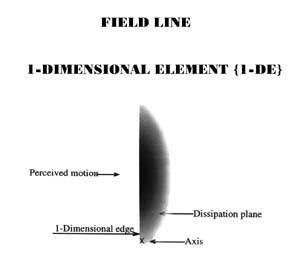If one breaks down the visual field into its basic components one eventually arrives at the atom of vision, which is 'The Dot'. The visual system processes all the dots in its field and creates strings of dots which are recognized as lines, and if such a line is extended at 90 degrees to its own axis it becomes a 2-dimensional plane.
THE BUILDING BLOCKS OF VISUAL PERCEPTION
FIG 1:
![]() STARTING
WITH DOTS AS THE FUNDEMENTAL TYPE, THEY ARE . ESSENTIALLY SYMBOLIC OF THE 0-DIMENSION
AND ARE
STARTING
WITH DOTS AS THE FUNDEMENTAL TYPE, THEY ARE . ESSENTIALLY SYMBOLIC OF THE 0-DIMENSION
AND ARE
REGARDED AS CORRUPT 0-DIMENSIONAL
LINES SINCE THEY ARE VISIBLE AND THEREFORE NOT DIMENSIONLESS.
![]() THE DOTS
THEN UNDERGO EXTENSION ALONG THE HORIZONTAL TO BECOME SYMBOLIC Of 1-DIMENSlONAL
LINES. THESE T00 ARE SEEN AS CORRUPT SINCE THEY ARE VISIBLE AND UNDER
THE MICROSCOPE THEY APPEAR AS 2-DIMENSIONAL PLANES. ITMUST BE REMEMBERED THAT
THE CONCERN IS THE NATURE OF THE IMAGE THAT FALLS UPON THE RETINA.
THE DOTS
THEN UNDERGO EXTENSION ALONG THE HORIZONTAL TO BECOME SYMBOLIC Of 1-DIMENSlONAL
LINES. THESE T00 ARE SEEN AS CORRUPT SINCE THEY ARE VISIBLE AND UNDER
THE MICROSCOPE THEY APPEAR AS 2-DIMENSIONAL PLANES. ITMUST BE REMEMBERED THAT
THE CONCERN IS THE NATURE OF THE IMAGE THAT FALLS UPON THE RETINA.
![]() THE LINES
THEN UNDERGO A VERTICAL EXTENSION TO BECOME SYMBOLIC, CORRUPT 2-DIMENSIONAL
PLANES.
THE LINES
THEN UNDERGO A VERTICAL EXTENSION TO BECOME SYMBOLIC, CORRUPT 2-DIMENSIONAL
PLANES.
A TRUE 1-DIMENSlONAL LINE OCCURS
AS AN EDGE WHOSE VERTICAL EXTENSION RESLULTS IN THE DISSPATION OF THE LINEINTO
THE BACKGROUND.
![]() THE ACTUAL
1-DIMENSlONAL LINE IS WHERE THE EDGE OF IT'S ASSOCIATED (DISSPATING) PLANE
MEETS THE PLANE OF
THE ACTUAL
1-DIMENSlONAL LINE IS WHERE THE EDGE OF IT'S ASSOCIATED (DISSPATING) PLANE
MEETS THE PLANE OF
THE BACKGROUND AND NOT WHERE IT
FADES AWAY. (See Fig 2 Below)
A plane with a black surround, however, is not a real plane it is a symbol for a plane but there is a type of line that exists in nature that can be called a 'molecule' of vision. It is the 1-dimensional line [fig.l]. It is rather like a shadow with only one edge. It is the intersection of two infinitely large 2-dimensional planes and it is not a symbolic object.
This 1-dimensional object was invented by me in mid-1984 as the result
of a similar analysis that was concerned in energizing the plane of a 2-dimensional
surface with a single type of element. The notion was to build 'energized'
surfaces by polarizing an array of such elements in such a way that used
the idiosyncrasies of visual perception to create illusions
of warped space while at the same time appealing to the elegance of
simplicity that physicists and mathematicians so often speak of. The first
thing was to organize the 2-D surface to take 1-D elements in an ordered
way and for this the surface was made into a grid of about 25 x 25 square
units. The corners of each unit represented an axis point to which a 1-D
element was hinged. The 'elements' could then take up any orientation about
the hinge axis. (See Field Lines)
 FIG
2:
FIG
2:
 FIG 3:
FIG 3:
![]()
![]()